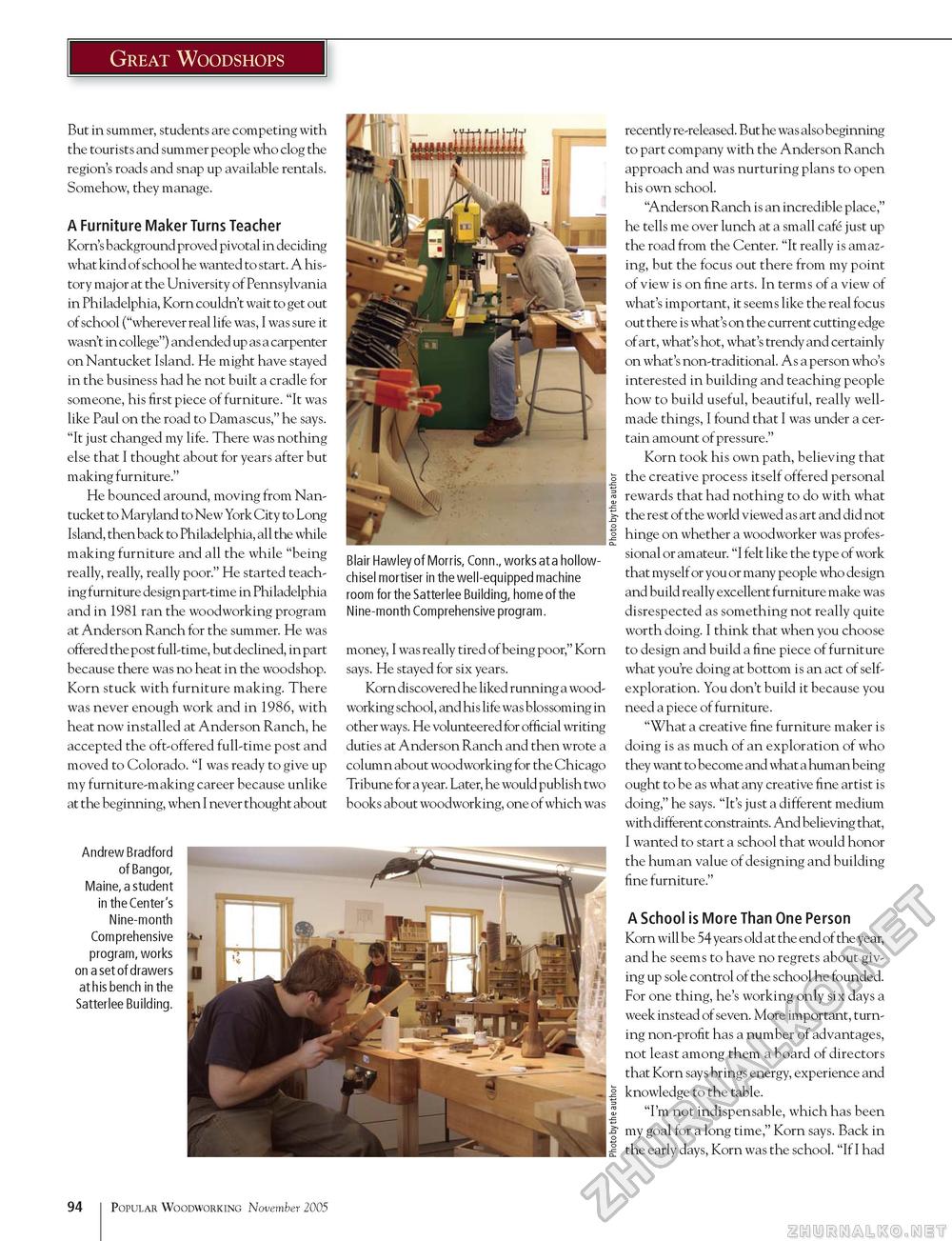Popular Woodworking 2005-11 № 151, страница 97
Great Woodshops But in summer, students are competing with the tourists and summer people who clog the region's roads and snap up available rentals. Somehow, they manage. A Furniture Maker Turns Teacher Korn's background proved pivotal in deciding what kind of school he wanted to start. A history maj or at the University of Pennsylvania in Philadelphia, Korn couldn't wait to get out of school ("wherever real life was, I was sure it wasn't in college") and ended up as a carpenter on Nantucket Island. He might have stayed in the business had he not built a cradle for someone, his first piece of furniture. "It was like Paul on the road to Damascus," he says. "It just changed my life. There was nothing else that I thought about for years after but making furniture." He bounced around, moving from Nan-tucket to Maryland to New York City to Long Island, then back to Philadelphia, all the while making furniture and all the while "being really, really, really poor." He started teaching furniture design part-time in Philadelphia and in 1981 ran the woodworking program at Anderson Ranch for the summer. He was offered the post full-time, but declined, in part because there was no heat in the woodshop. Korn stuck with furniture making. There was never enough work and in 1986, with heat now installed at Anderson Ranch, he accepted the oft-offered full-time post and moved to Colorado. "I was ready to give up my furniture-making career because unlike at the beginning, when I never thought about Blair Hawley of Morris, Conn., works at a hollow-chisel mortiser in the well-equipped machine room for the Satterlee Building, home of the Nine-month Comprehensive program. money, I was really tired of being poor," Korn says. He stayed for six years. Korn discovered he liked running a woodworking school, and his life was blossoming in other ways. He volunteered for official writing duties at Anderson Ranch and then wrote a column about woodworking for the Chicago Tribune for a year. Later, he would publish two books about woodworking, one of which was Andrew Bradford of Bangor, Maine, a student in the Center's Nine-month Comprehensive program, works on a set of drawers at his bench in the Satterlee Building. recently re-released. But he was also beginning to part company with the Anderson Ranch approach and was nurturing plans to open his own school. "Anderson Ranch is an incredible place," he tells me over lunch at a small cafe just up the road from the Center. "It really is amazing, but the focus out there from my point of view is on fine arts. In terms of a view of what's important, it seems like the real focus out there is what's on the current cutting edge of art, what's hot, what's trendy and certainly on what's non-traditional. As a person who's interested in building and teaching people how to build useful, beautiful, really well-made things, I found that I was under a certain amount of pressure." Korn took his own path, believing that the creative process itself offered personal rewards that had nothing to do with what the rest of the world viewed as art and did not hinge on whether a woodworker was professional or amateur. "I felt like the type of work that myself or you or many people who de sign and build really excellent furniture make was disrespected as something not really quite worth doing. I think that when you choose to design and build a fine piece of furniture what you're doing at bottom is an act of self-exploration. You don't build it because you need a piece of furniture. "What a creative fine furniture maker is doing is as much of an exploration of who they want to become and what a human being ought to be as what any creative fine artist is doing," he says. "It's just a different medium with different constraints. And believing that, I wanted to start a school that would honor the human value of designing and building fine furniture." A School is More Than One Person Korn will be 54 years old at the end of the year, and he seems to have no regrets about giving up sole control of the school he founded. For one thing, he's working only six days a week instead of seven. More important, turning non-profit has a number of advantages, not least among them a board of directors that Korn says brings energy, experience and knowledge to the table. "I'm not indispensable, which has been my goal for a long time," Korn says. Back in the early days, Korn was the school. "If I had 94 Popular Woodworking November 2005 |








